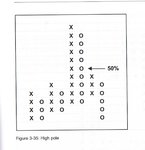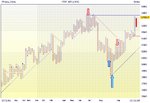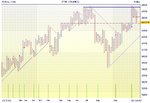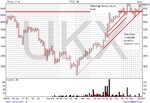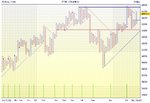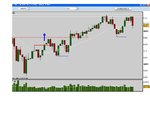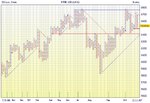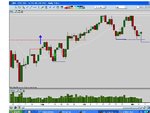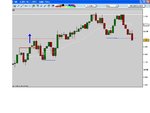Hi develbis,
No, no experience of trading high poles as such or any other P&F pattern for that matter! I'm not at all keen on any kind of established pattern, be they 'high poles' in the context of P&F charts, 'hammers' in the context of candlestick charts or whatever. I conciously fight this pattern of thinking which so many (inexperienced) traders fall into. I include myself in this group. The thinking goes along the lines of there's a head and shoulders, therefore the instrument is set to tank and I'll short it or, there's a bullish engulfing candle, therefore I'll go long. Lots of people have lost a lot of money thinking like this (me included) and T.A. has earned itself a bad reputation.
Attached is the usual FTSE 100 chart with 2 high poles and 2 low poles that have occured since the June highs. I'm no expert, so I may have missed some or mis-identified the ones shown, so feel free to challenge me! Like I say, I don't pay much attention to such patterns. That said, the first high pole (1st red arrow) would have got you out of a long position near the high or, conversely, got you into a short position. The first low pole (1st bloo arrow) turned out to be a failed signal and would have got you out of a short too soon and/or into a long trade prematurely. However, the second low pole (2nd bloo arrow) would have worked a treat. IF I acted on such patterns, I'd be inclined to take the view that to have the same pattern in straight succession is sooooo unusual that the probability of the second one working out was high. The second high pole (2nd red arrow) is also a failed signal but, arguably, it appears in the context of a downtrend. Given that the high/low pole is a reversal pattern and not a continuation pattern, this 'signal' is at best, weak.
Lastly, if the current column of bloo 'X's is the start of a high pole signaling an iminent reversal, the subsequent column of red 'O's must fall at least as far as 6575, indicated by the bold virtical red line.
I disagree. By definition, a reversal pattern will get you into a trade counter to the prevailing trend. The first red and both bloo arrows are good examples of this. As such, my personal view is that reversal patterns such as poles are useful as a means for taking some or all profits, but are very dangerous tools to utilize for entering new positions. Just my view of course 😉
Tim.

